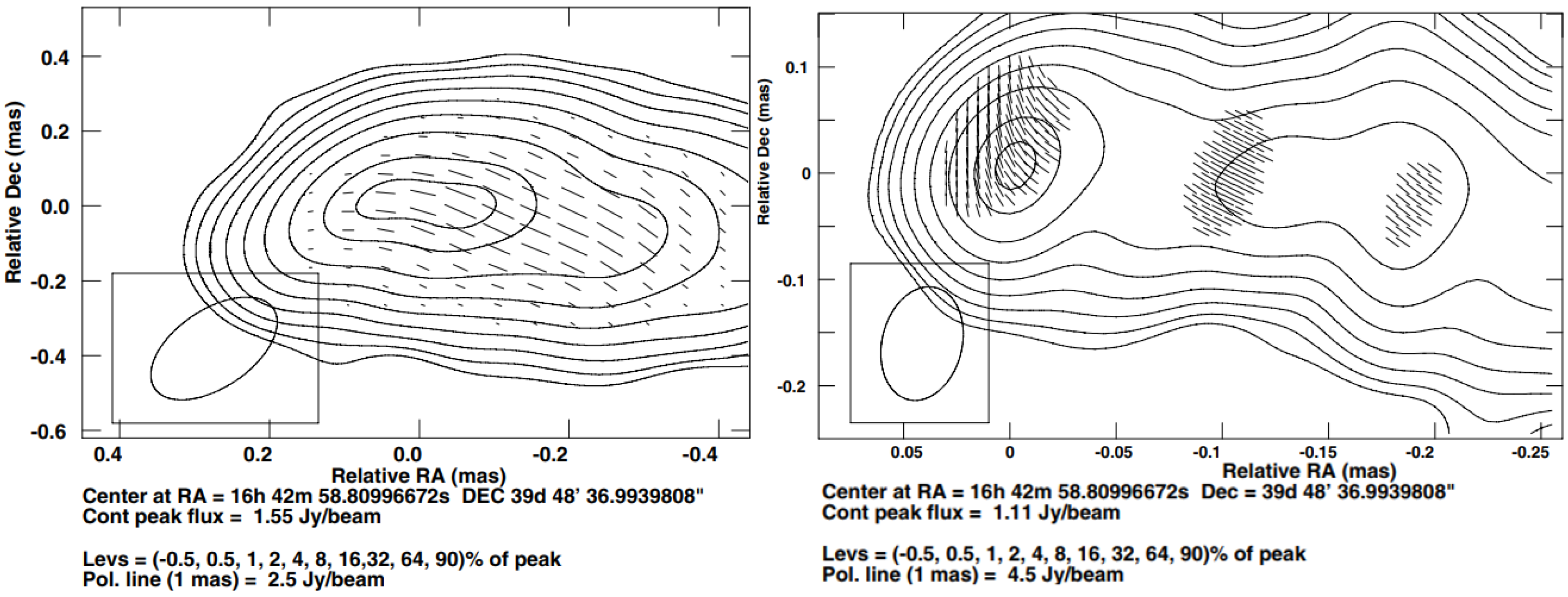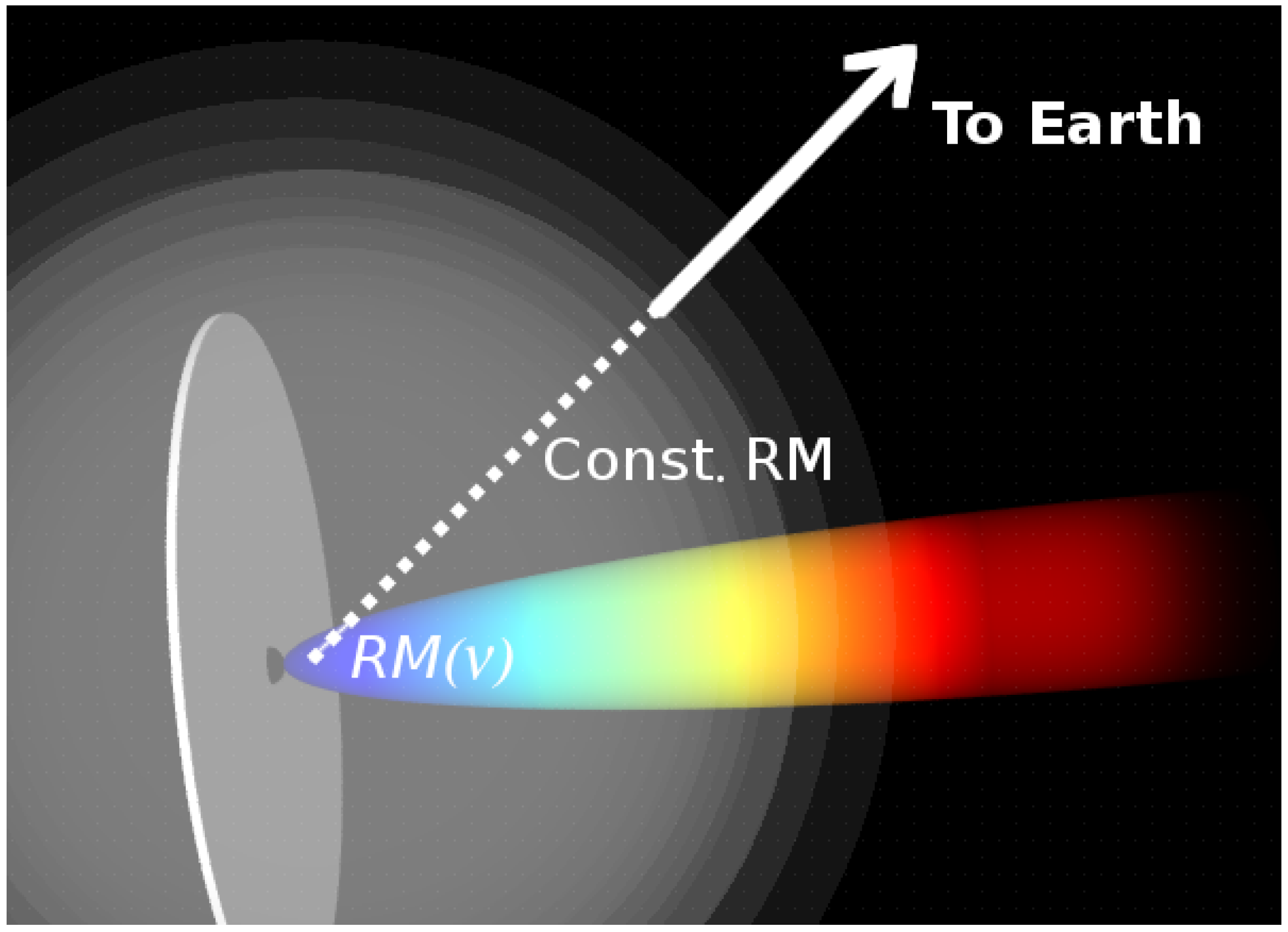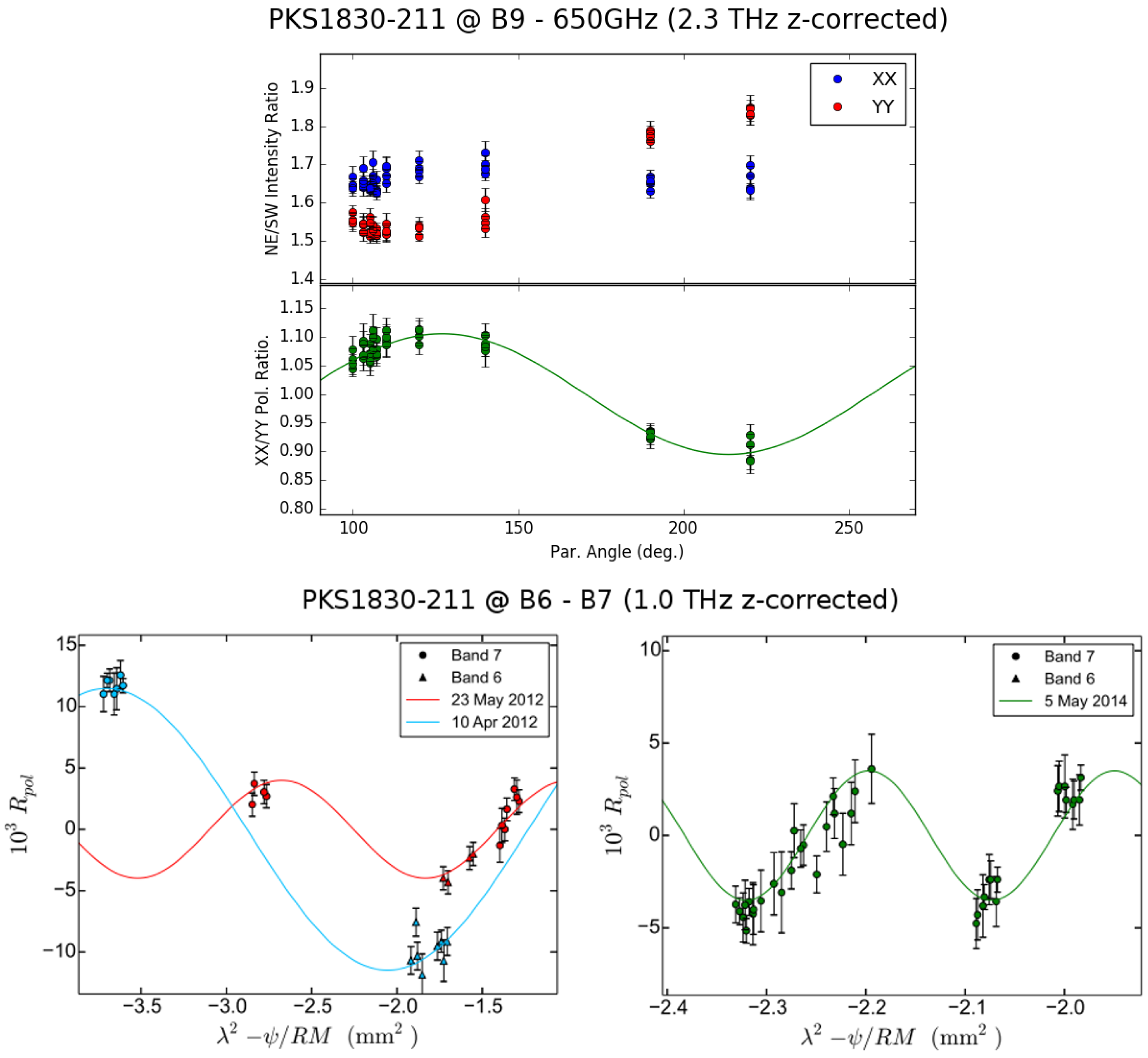High-Sensitivity AGN Polarimetry at Sub-Millimeter Wavelengths
Abstract
:1. Introduction
2. High-Sensitivity Submm Observations of AGN: Variability and Polarimetry
2.1. Submm Differential Polarimetry of PKS 1830−211
2.2. Polarization of PKS 1830−211 at the Highest Radio Frequencies
2.3. Differential Polarimetry on Another Gravitational Lens
3. Summary
Acknowledgments
Author Contributions
Conflicts of Interest
Abbreviations
| SMBH | Super Massive Black Hole |
| AGN | Active Galactic Nucleus |
| EVPA | Electric Vector Position Angle |
| RM | Rotation Measure |
| SSA | Synchrotron Self-Absorption |
| mm/sub-mm | millimeter/sub-millimeter |
| ALMA | Atacama Large mm/submm Array |
| VLA | Very Large Array |
| VLBA | Very Long Baseline Array |
| VLBI | Very Long Baseline Interferometry |
References
- Blandford, R.D.; Znajek, R.L. Electromagnetic extraction of energy from Kerr black holes. Mon. Not. Roy. Astron. Soc. 1977, 179, 433–456. [Google Scholar] [CrossRef]
- Komissarov, S.S.; Barkov, M.V.; Vlahakis, N.; Königl, A. Magnetic acceleration of relativistic active galactic nucleus jets. Mon. Not. Roy. Astron. Soc. 2007, 380, 51–70. [Google Scholar] [CrossRef]
- Kikuchi, S.; Mikami, Y.; Inoue, M.; Tabara, H.; Kato, T. A synchronous variation of polarization angle in OJ 287 in the optical and radio regions. Astron. Astrophys. 1988, 190, L8–L10. [Google Scholar]
- Marscher, A.P.; Jorstad, S.G.; D’Arcangelo, F.D.; Smith, P.S.; Williams, G.G.; Larionov, V.M.; Oh, H.; Olmstead, A.R.; Aller, M.F.; Aller, H.D.; et al. The inner jet of an active galactic nucleus as revealed by a radio-to-γ-ray outburst. Nature. 2008, 452, 966–969. [Google Scholar] [CrossRef] [PubMed]
- Algaba, J.C.; Gabuzda, D.C.; Smith, P.S. Search for correlations between the optical and radio polarization of active galactic nuclei—II. VLBA polarization data at 12+15+22+24+43 GHz. Mon. Not. Roy. Astron. Soc. 2012, 411, 85–101. [Google Scholar] [CrossRef]
- Blinov, D.; Pavlidou, V.; Papadakis, I.E.; Hovatta, T.; Pearson, T.J.; Liodakis, I.; Panopoulou, G.V.; Angelakis, E.; Baloković, M.; Das, H.; et al. RoboPol: Optical polarization-plane rotations and flaring activity in blazars. Mon. Not. Roy. Astron. Soc. 2016, 457, 2252–2262. [Google Scholar] [CrossRef]
- Fuhrmann, L.; Larsson, S.; Chiang, J.; Angelakis, E.; Zensus, J.A.; Nestoras, I.; Krichbaum, T.P.; Ungerechts, H.; Sievers, A.; Pavlidou, V.; et al. Detection of significant cm to sub-mm band radio and γ-ray correlated variability in Fermi bright blazars. Mon. Not. Roy. Astron. Soc. 2014, 441, 1899–1909. [Google Scholar] [CrossRef]
- Fuhrmann, L.; Angelakis, E.; Zensus, J.A.; Nestoras, I.; Marchili, N.; Pavlidou, V.; Karamanavis, V.; Ungerechts, H.; Krichbaum, T.P.; Larsson, S.; et al. The F-GAMMA programme: multi-frequency study of active galactic nuclei in the Fermi era. Programme description and the first 2.5 years of monitoring. Astron. Astrophys. 2016, 596, A45. [Google Scholar] [CrossRef]
- Karamanavis, V.; Fuhrmann, L.; Angelakis, E.; Nestoras, I.; Myserlis, I.; Krichbaum, T.P.; Zensus, J.A.; Ungerechts, H.; Sievers, A.; Gurwell, M.A. What can the 2008/10 broadband flare of PKS 1502+106 tell us? Nuclear opacity, magnetic fields, and the location of γ rays. Astron. Astrophys. 2016, 590, A48. [Google Scholar] [CrossRef]
- Martí-Vidal, I.; Muller, S.; Combes, F.; Aalto, S.; Beelen, A.; Darling, J.; Guélin, M.; Henkel, C.; Horellou, C.; Marcaide, J.M.; et al. Probing the jet base of the blazar PKS 1830-211 from the chromatic variability of its lensed images. Serendipitous ALMA observations of a strong gamma-ray flare. Astron. Astrophys. 2013, 558, A123. [Google Scholar] [CrossRef]
- Gabuzda, D.C.; Chernetskii, V.A. Parsec-scale Faraday rotation distribution in the BL Lac object 1803+784. Mon. Not. Roy. Astron. Soc. 2003, 339, 669–679. [Google Scholar] [CrossRef]
- Kuo, C.Y.; Asada, K.; Rao, R.; Nakamura, M.; Algaba, J.C.; Liu, H.B.; Inoue, M.; Koch, P.M.; Ho, P.T.P.; Matsushita, S.; et al. Measuring Mass Accretion Rate onto the Supermassive Black Hole in M87 Using Faraday Rotation Measure with the Submillimeter Array. Astrophys. J. 2014, 783, L33. [Google Scholar] [CrossRef]
- Mahmud, M.; Gabuzda, D.C.; Bezrukovs, V. Surprising evolution of the parsec-scale Faraday Rotation gradients in the jet of the BL Lac object B1803+784. Mon. Not. Roy. Astron. Soc. 2009, 400, 2–12. [Google Scholar] [CrossRef]
- Martí-Vidal, I.; Muller, S.; Vlemmings, W.H.T.; Horellou, C.; Aalto, S. A strong magnetic field in the jet base of a supermassive black hole. Science 2015, 348, 311–314. [Google Scholar] [CrossRef] [PubMed]
- Abdo, A.A.; Ackermann, M.; Ajello, M.; Axelsson, M.; Baldini, L.; Ballet, J.; Barbiellini, G.; Bastieri, D.; Baughman, B.M.; Bechtol, K.; et al. A change in the optical polarization associated with a γ-ray flare in the blazar 3C279. Nature 2010, 463, 919. [Google Scholar] [CrossRef] [PubMed]
- Marscher, A.P. Turbulent, Extreme Multi-zone Model for Simulating Flux and Polarization Variability in Blazars. Astrophys. J. 2014, 780, 87–97. [Google Scholar] [CrossRef]
- Zhang, H.; Chen, X.; Böttcher, M.; Guo, F.; Li, H. Polarization Swings Reveal Magnetic Energy Dissipation in Blazars. Astrophys. J. 2015, 804, 58–69. [Google Scholar] [CrossRef]
- Agudo, I.; Marscher, A.P.; Jorstad, S.G.; Larionov, V.M.; Gómez, J.L.; Lähteenmäki, A.; Smith, P.S.; Nilsson, K.; Readhead, A.C.S.; Aller, M.F.; et al. On the Location of the γ-Ray Outburst Emission in the BL Lacertae Object AO 0235+164 Through Observations Across the Electromagnetic Spectrum. Astrophys. J. 2011, 735, L10–L17. [Google Scholar] [CrossRef]
- Agudo, I.; Jorstad, S.G.; Marscher, A.P.; Larionov, V.M.; Gómez, J.L.; Lähteenmäki, A.; Gurwell, M.; Smith, P.S.; Wiesemeyer, H.; Thum, C.; et al. Location of γ-ray Flare Emission in the Jet of the BL Lacertae Object OJ287 More than 14 pc from the Central Engine. Astrophys. J. 2011, 726, L13–L19. [Google Scholar] [CrossRef]
- Martí-Vidal, I.; Krichbaum, T.P.; Marscher, A.P.; Alef, W.; Bertarini, A.; Bach, U.; Schinzel, F.K.; Rottmann, H.; Anderson, J.M.; Zensus, J.A.; et al. On the calibration of full-polarization 86 GHz global VLBI observations. Astron. Astrophys. 2012, 542, A107. [Google Scholar] [CrossRef]
- Martí-Vidal, I.; Muller, S.; Vlemmings, W.H.T.; Casey, S. UVMULTIFIT: A versatile tool for fitting astronomical radio interferometric data. Astron. Astrophys. 2014, 563, A136. [Google Scholar] [CrossRef]
- Barnacka, A.; Glicenstein, J.-F.; Moudden, Y. First evidence of a gravitational lensing-induced echo in gamma rays with Fermi LAT. Astron. Astrophys. 2011, 528, L3. [Google Scholar] [CrossRef]
- Martí-Vidal, I.; Vlemmings, W.H.T.; Muller, S. Dual differential polarimetry. A technique to recover polarimetric information from dual-polarization observations. Astron. Astrophys. 2016, 593, A61. [Google Scholar] [CrossRef]
- Garrett, M.A.; Leppaenen, K.; Porcas, R.W.; Patnaik, A.R.; Nair, S.; Teraesranta, H. PKS 1830-211: VLBA lambda 7mm Polarization Observations. Proceedings of the Radio Emission from Galactic and Extragalactic Compact Sources 313–314. [CrossRef]
- Martí-Vidal, I.; Muller, S. Using gravitationally lensed images to investigate the intrinsic AGN variability. Astron. Astrophys. 2016, 590, A83. [Google Scholar] [CrossRef]
- Edge, D.O.; Shakeshaft, J.R.; McAdam, W.B.; Baldwin, J.E.; Archer, S. A survey of radio sources at a frequency of 159 Mc/s. Mon. Not. Roy. Astron. Soc., 1959, 68, 37–60. [Google Scholar]






© 2017 by the authors. Licensee MDPI, Basel, Switzerland. This article is an open access article distributed under the terms and conditions of the Creative Commons Attribution (CC BY) license (http://creativecommons.org/licenses/by/4.0/).
Share and Cite
Martí-Vidal, I.; Muller, S. High-Sensitivity AGN Polarimetry at Sub-Millimeter Wavelengths. Galaxies 2017, 5, 65. https://doi.org/10.3390/galaxies5040065
Martí-Vidal I, Muller S. High-Sensitivity AGN Polarimetry at Sub-Millimeter Wavelengths. Galaxies. 2017; 5(4):65. https://doi.org/10.3390/galaxies5040065
Chicago/Turabian StyleMartí-Vidal, Ivan, and Sébastien Muller. 2017. "High-Sensitivity AGN Polarimetry at Sub-Millimeter Wavelengths" Galaxies 5, no. 4: 65. https://doi.org/10.3390/galaxies5040065




